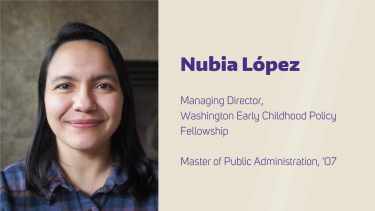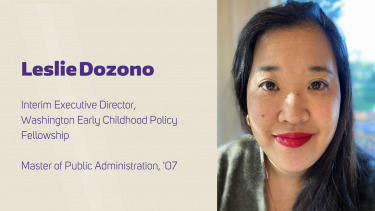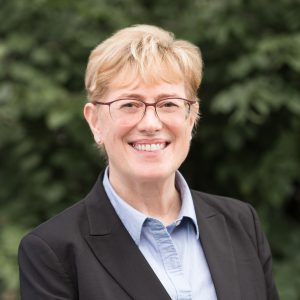Driven by a passion for growing the number of BIPOC leaders in early childhood education and advancing anti-racism policy and practice, Evans School alumni Leslie Dozono (MPA ’07)and Nubia Lopez (MPA ’07) are working for a more just and equitable future in early childhood education leadership. We asked them about their work with the Washington Childhood Policy Fellowship and how their Evans School experience shaped where they are today.
What contributed to your decision to pursue a career in support of the public good? Was there a defining moment in particular?
 Nubia: As an undergraduate I majored in political science, and I worked closely with a professor who taught courses that opened my eyes to the politics and systems that I hadn’t really considered until then. Initially I was extremely interested in international politics, but then started working in a kindergarten classroom as a paraeducator. Through this job and my formal education, I started seeing the world through a different lens, one where I understood that our social systems are designed and intentional, and that happens through policy. When I came to the Evans School I chose to focus on social and education policy. I wanted to be more than just critical of our social systems and structures, I wanted to dedicate my career towards creating more equitable systems and structures—systems that work for everyone, not just those with privilege and access.
Nubia: As an undergraduate I majored in political science, and I worked closely with a professor who taught courses that opened my eyes to the politics and systems that I hadn’t really considered until then. Initially I was extremely interested in international politics, but then started working in a kindergarten classroom as a paraeducator. Through this job and my formal education, I started seeing the world through a different lens, one where I understood that our social systems are designed and intentional, and that happens through policy. When I came to the Evans School I chose to focus on social and education policy. I wanted to be more than just critical of our social systems and structures, I wanted to dedicate my career towards creating more equitable systems and structures—systems that work for everyone, not just those with privilege and access.
 Leslie: I’ve always worked with kids and education so nonprofit/public work has been a natural path for my professional life. I was an English major in undergraduate and afterwards I worked at a nonprofit that had a focus on literacy. I think a significant professional turning point for me was the shift from direct service to policy. When I moved to Seattle, I was lucky to work with an amazing team of people at Atlantic Street Center where we offered youth development, counseling and case management, and family services. My experiences at our Summer Academy program, particularly with kindergartners, served as a catalyst for my commitment to early childhood as a field and my realization that I wanted to move from direct service to policy. There were so many things happening for the children and families we served—ongoing challenges for their overall success – that were systemic and much larger than what I could see on the ground. Looking upstream both in terms of age and in terms of policy made a lot of sense to me when I thought about the impact I wanted to have.
Leslie: I’ve always worked with kids and education so nonprofit/public work has been a natural path for my professional life. I was an English major in undergraduate and afterwards I worked at a nonprofit that had a focus on literacy. I think a significant professional turning point for me was the shift from direct service to policy. When I moved to Seattle, I was lucky to work with an amazing team of people at Atlantic Street Center where we offered youth development, counseling and case management, and family services. My experiences at our Summer Academy program, particularly with kindergartners, served as a catalyst for my commitment to early childhood as a field and my realization that I wanted to move from direct service to policy. There were so many things happening for the children and families we served—ongoing challenges for their overall success – that were systemic and much larger than what I could see on the ground. Looking upstream both in terms of age and in terms of policy made a lot of sense to me when I thought about the impact I wanted to have.
Can you share a bit about the work you are currently doing and what a typical day in your work looks like?
We’re working to establish a new nonprofit in Washington state, the Washington Early Childhood Policy Fellowship. The focus is on two things: Increasing the number of Black, Indigenous, and other People of Color (BIPOC) leaders in early childhood policy in Washington state and advancing anti-racism policy and practice in the larger early childhood policy system. We recognize that cultivating and supporting individual BIPOC leadership is important for progress in addressing persistent disparate racialized outcomes for young children, but at the same time, the broader field needs to be aligned and committed to understanding and centering anti-racism in policy to achieve transformational change.
We’re very much in the start-up phase of building an organization, which means we have a lot to think about! Our focus is split between leadership/governance, program design, and fund development. We are currently fiscally sponsored through the Southeast Seattle Education Coalition (SESEC), and we’ve been establishing our Founding Board and the internal structural components required to establish as an independent 501(c)3. That means developing our mission, bylaws, our Board structure, and relationships, all the while thinking about our long-term governing board and readying to launch a search for our inaugural Executive Director. Concurrently, we’re working on building the programmatic components of a placement-based Fellowship that combines employment with significant professional development and mentorship. Relationship-intensive work takes significant resources, so we are also deep in fund development, making sure we have the investments we need to launch and sustain this work.
You have both been champions of Diversity, Equity, and Inclusion throughout your careers. Can you share why this has been so central to you and the work you continue doing?
Nubia: This work is personal for me. It is about my own lived experience and background. My family immigrated to the US from Mexico when I was 3 years old, and my parents didn’t speak English and I didn’t learn English until I started elementary school. We were a low-income family, relying on social services. I saw my parents constantly struggle to make ends meet, even though both of my parents worked multiple jobs. It took me some time to realize that struggles were not personal failings of my family or my community, but predictable outcomes based on our lack of access to resources and opportunities—this is central to equity work. For me, equity is about providing access and resources so that everyone can thrive
Going from my personal experience to our work with the Fellowship, our work is about having diverse voices at the decision-making tables. How can we ensure that BIPOC leaders who have these lived experiences are provided with opportunities to influence decisions that impact young children and families? And, beyond that, how can we support and build their capacity to have an impact on early childhood policies and systems? I truly believe these perspectives are critical to creating early childhood policies to support those who are most impacted and have been traditionally excluded from participating in the decision-making process.
Leslie: My parents are both immigrants and my dad talked a lot with my sisters and I about his experiences with racism and exclusion. Growing up in a largely white community in Oregon, the experience of feeling othered is something I carried through much of my childhood. And I think as a Japanese American, it is impossible to separate out the personal and the societal when you think about the collective trauma of internment and the resulting emphasis on assimilation and what that has meant for language and culture – for our parents’ generation’s focus on achieving a particular kind of mainstream success. I think about the difference between feeling shame and pride as a child about my heritage and what it means to create systems that honor the cultures and strengths of our communities.
On a larger scale, I don’t think you can successfully work for the public good without racial equity and anti-racism as core tenets. When we look at outcomes for children, for families, for individuals, and for our workforce and in our economy, there are glaring racial inequities.
One of the beliefs we carry in our work with the Fellowship is that communities who are most impacted by educational injustices must be represented in positions of power within policy development processes and decision-making to identify and address complex, structural inequities that are detrimental to all. Beyond the moral obligations we have in our society around fairness and justice, which I think were ingrained in me from an early age, it’s also practical. We cannot achieve shared prosperity and a thriving society without racial equity and anti-racism work. The opportunity gap in early childhood has huge implications for children in school and life and it also has implications for our public systems. Greater costs in special education and other supportive services, greater costs to the criminal legal system, and down the road, a less qualified workforce. And it’s more than just education systems. Supporting families in early childhood – a time with woefully inadequate public policy and investment in families – can also mean a reduction in child welfare services, greater prevention in health and mental health services, all of which reduce both human and economic cost. Centering the families most impacted is essential for identifying and implementing solutions and for our shared success.
If there was one thing you would want everyone to know about your work, what would it be?
We think our Core Beliefs and Commitments to Action reflect how we think about and are approaching this work. They underscore something that has become increasingly clear to us over time: at the foundation of progress is relationships and trust. These are necessary to impact complex systems and effect system-change. Creating intentional space for BIPOC leaders – spaces that we did not always have ourselves – is a critical part of this work.
Looking back on your Evans School experience, what stands out as being particularly impactful during that time?
Our work with the Partnership for Cultural Diversity (PCD) was a big part of our Evans School experience. We spent a lot of time doing what we learned to do at Evans in the public sphere but focused internally on the school itself: collective stakeholder work to identify issues, thinking through a theory of change and what we had agency to work on, prioritization and action, and planning around succession and leadership. Even then, we focused a lot of attention on leadership and representation. For example, we spent most of most time and energy when we were co-leads of PCD on faculty diversity and hiring. It’s really no coincidence that there are a lot of common themes in the work we did together in graduate school and what we are doing now.
How does your Evans education impact how you approach your work today?
Nubia: As I mentioned, my undergraduate education gave me broad theoretical knowledge and opened my worldview. It was at Evans where I learned how to make that theory actionable. If I was going to pick one particular concept that is most impactful, it would be the importance of stakeholder engagement. This is something that also goes back to the value of Diversity, Equity, and Inclusion. At Evans, I was introduced to the notion that as public policy professionals, we must engage with the people who have a vested interest in the specific program or policy being worked on. Furthermore, we must ensure that we are intentionally seeking out these critically important diverse perspectives and inviting them into the conversation. Critically, we must then truly value their contributions, ideally making better decisions because we have taken the time to proactively seek out stakeholders. I have used various racial equity tools throughout my career, and a central analytical component is to engage with those most impacted to assess benefit or burden from their perspective, ultimately, ensuring that the policy or program being worked on is pro-equity. The stakeholder engagement was a seed planted at Evans and has evolved over my career with a specific racial equity lens.
Leslie: Three things come to my mind pretty quickly: memos, leadership, and mentorship. Graduate school helped me learn to write in ways that were more thoughtful about the goals of communication and the structures that are useful to communicate complex information in accessible ways. I do think the most valuable experience I had at Evans was the work Nubia and I did leading PCD. We were students within the structure of a graduate program designed to prepare people for external work in the public sector and nonprofit work, which itself had strengths and weaknesses, particularly when it came to race. Pushing from within about how important racial equity work and the responsibility of institutions to further that work was another step in my personal and professional journey and thinking about how I used my positional power and agency to move change. I’ve been thinking about a lot lately about mentorships I’ve had – and at Evans I would specifically point to David Harrison – and people who have made me feel like I had the skills and abilities to engage. I distinctly remember a moment when I expressed doubt in my analysis in a class, and afterwards he told me that I could sit at any table and hold my own. It meant a lot to me because I knew he had been at a lot of tables and I held him in such high regard. I still think about his words when I’m feeling unsure and use them to bolster myself up sometimes – and it was 14 years ago! It made me even more aware of my responsibility to offer encouragement and support to others as I’ve advanced in my own career.
What are one or two resources that inspire you personally or professionally?
Leslie: My sister gave me We Will Not Cancel Us and Other Dreams of Transformative Justice by Adrienne Maree Brown a couple of years ago and it really resonated with me. In terms of early childhood, University of Washington’s own Institute for Learning and Brain Sciences (I-LABS) has been producing strong research on the impact of the earliest years on brain development. I-LABS and the Center on the Developing Child at Harvard University are great sources of information and data on why we should care both as individuals and as a broader society about the unparalleled period of human development in early childhood.
Nubia: I would point to the PBS documentary and recently updated website (new resources from 2020): Race: The Power of Illusion. I have used parts of the documentary in many trainings on race over the years, and it has been very eye-opening for my own understanding on how as a nation we have created racial categories and then created institutions and policies to reinforce those categories. It underscores who is represented when policies are created matters. We must have multiple perspectives represented, especially those who have been historically left out and marginalized, and this is why I believe the work of the WA ECP Fellowship is so important.

 The National Science Foundation (NSF) funded a multi-institutional team (the
The National Science Foundation (NSF) funded a multi-institutional team (the  Nubia: As an undergraduate I majored in political science, and I worked closely with a professor who taught courses that opened my eyes to the politics and systems that I hadn’t really considered until then. Initially I was extremely interested in international politics, but then started working in a kindergarten classroom as a paraeducator. Through this job and my formal education, I started seeing the world through a different lens, one where I understood that our social systems are designed and intentional, and that happens through policy. When I came to the Evans School I chose to focus on social and education policy. I wanted to be more than just critical of our social systems and structures, I wanted to dedicate my career towards creating more equitable systems and structures—systems that work for everyone, not just those with privilege and access.
Nubia: As an undergraduate I majored in political science, and I worked closely with a professor who taught courses that opened my eyes to the politics and systems that I hadn’t really considered until then. Initially I was extremely interested in international politics, but then started working in a kindergarten classroom as a paraeducator. Through this job and my formal education, I started seeing the world through a different lens, one where I understood that our social systems are designed and intentional, and that happens through policy. When I came to the Evans School I chose to focus on social and education policy. I wanted to be more than just critical of our social systems and structures, I wanted to dedicate my career towards creating more equitable systems and structures—systems that work for everyone, not just those with privilege and access. Leslie: I’ve always worked with kids and education so nonprofit/public work has been a natural path for my professional life. I was an English major in undergraduate and afterwards I worked at a nonprofit that had a focus on literacy. I think a significant professional turning point for me was the shift from direct service to policy. When I moved to Seattle, I was lucky to work with an amazing team of people at Atlantic Street Center where we offered youth development, counseling and case management, and family services. My experiences at our Summer Academy program, particularly with kindergartners, served as a catalyst for my commitment to early childhood as a field and my realization that I wanted to move from direct service to policy. There were so many things happening for the children and families we served—ongoing challenges for their overall success – that were systemic and much larger than what I could see on the ground. Looking upstream both in terms of age and in terms of policy made a lot of sense to me when I thought about the impact I wanted to have.
Leslie: I’ve always worked with kids and education so nonprofit/public work has been a natural path for my professional life. I was an English major in undergraduate and afterwards I worked at a nonprofit that had a focus on literacy. I think a significant professional turning point for me was the shift from direct service to policy. When I moved to Seattle, I was lucky to work with an amazing team of people at Atlantic Street Center where we offered youth development, counseling and case management, and family services. My experiences at our Summer Academy program, particularly with kindergartners, served as a catalyst for my commitment to early childhood as a field and my realization that I wanted to move from direct service to policy. There were so many things happening for the children and families we served—ongoing challenges for their overall success – that were systemic and much larger than what I could see on the ground. Looking upstream both in terms of age and in terms of policy made a lot of sense to me when I thought about the impact I wanted to have.